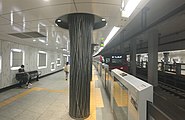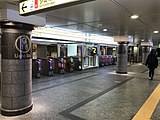Ueno Station (上野駅, Ueno-eki) is a major railway station in Tokyo's Taitō ward. It is the station used to reach the Ueno district and Ueno Park—which contains Tokyo National Museum, The National Museum of Western Art, Ueno Zoo, Tokyo University of the Arts and other famous cultural facilities. A major commuter hub, it is also the traditional terminus for long-distance trains from northern Japan, although with the extension of the Shinkansen lines to Tokyo Station this role has diminished in recent years. A similar extension of conventional lines extended Takasaki Line, Utsunomiya Line and Jōban Line services to Tokyo Station via the Ueno-Tokyo Line in March 2015, using existing little-used tracks and a new viaduct; the Ueno-Tokyo Line connects these lines with the Tōkaidō Main Line, allowing through services to Shinagawa, Yokohama, Odawara and Atami stations.[1]
UENJU02JK30JY05JJ01 G16 H18 Ueno Station 上野駅 | |||||||||||||||||||||||||||||||||||||||||||||||
|---|---|---|---|---|---|---|---|---|---|---|---|---|---|---|---|---|---|---|---|---|---|---|---|---|---|---|---|---|---|---|---|---|---|---|---|---|---|---|---|---|---|---|---|---|---|---|---|
 Main building of the station | |||||||||||||||||||||||||||||||||||||||||||||||
| General information | |||||||||||||||||||||||||||||||||||||||||||||||
| Location | 7 Ueno (JR Station) 3 Higashi-Ueno (Tokyo Metro) Taitō, Tokyo Japan | ||||||||||||||||||||||||||||||||||||||||||||||
| Operated by | |||||||||||||||||||||||||||||||||||||||||||||||
| Line(s) | |||||||||||||||||||||||||||||||||||||||||||||||
| Connections |
| ||||||||||||||||||||||||||||||||||||||||||||||
| History | |||||||||||||||||||||||||||||||||||||||||||||||
| Opened | 28 July 1883 | ||||||||||||||||||||||||||||||||||||||||||||||
| Services | |||||||||||||||||||||||||||||||||||||||||||||||
| |||||||||||||||||||||||||||||||||||||||||||||||
| |||||||||||||||||||||||||||||||||||||||||||||||
| Location | |||||||||||||||||||||||||||||||||||||||||||||||
Ueno Station is close to Keisei Ueno Station, the Tokyo terminus of the Keisei Main Line to Narita Airport Station.
Lines
This station is served by the following lines:
As this station was the traditional point of arrival and departure for journeys to northern Japan, it became the inspiration for many poems and song lyrics, including a famous poem by Ishikawa Takuboku. There is a memorial plate about this poem in the station.
Station layout


Like most major stations in Japan, Ueno Station contains and is surrounded by extensive shopping arcades. The station contains a branch of the Hard Rock Cafe.
JR East platforms

The station has two main levels of tracks and underground platforms for the Tōhoku Shinkansen tracks. Through tracks 1 to 4 on two island platforms on the main level are used by Yamanote Line and Keihin-Tohoku Line trains. Tracks 5 to 9 on two island platforms and one side of a terminal platform lead to the Ueno-Tokyo Line to Tokyo Station and beyond on the Tōkaidō Main Line. Tracks 10 to 12 terminate inside the building, and below these on a lower deck are further terminal tracks 13 to 17 (Track No.18 has been removed). Two subterranean island platforms serve Shinkansen tracks 19 to 22.
Chest-high platform edge doors were installed on the two Yamanote Line platforms (2 and 3) in November 2015, and brought into use from December.[2]
| 1 | JK Keihin-Tōhoku Line | for Tabata, Akabane, Minami-Urawa, and Ōmiya |
| 2 | JY Yamanote Line | for Tabata, Ikebukuro, and Shinjuku |
| 3 | JY Yamanote Line | for Tokyo and Shinagawa |
| 4 | JK Keihin-Tōhoku Line | for Tokyo, Kawasaki, Yokohama JK Negishi Line for Ōfuna |
| 5-8 | JU Utsunomiya Line | for Ōmiya, Koga, Oyama, Utsunomiya |
| JU Takasaki Line | for Ōmiya, Ageo, Kumagaya, and Takasaki | |
| 6 | JJ Jōban Line | for Matsudo, Toride, Tsuchiura, Ishioka, Tomobe, and Mito ■ Narita Line for Narita (via Abiko) |
| 7-9 | JU Ueno–Tokyo Line | for Tokyo, Shinagawa, Yokohama and Odawara |
| 8 | ■ Jōban Line | □ Ltd. Express Hitachi / Tokiwa for Tsuchiura, Ishioka, Tomobe, Mito, Hitachi, and Iwaki |
| 9-12 | JJ Jōban Line | for Matsudo, Toride, Tsuchiura, and Mito ■ Narita Line for Narita (via Abiko) |
| 13-15 | JU Utsunomiya Line | for Ōmiya, Koga, Oyama, Utsunomiya |
| JU Takasaki Line | for Ōmiya, Ageo, Kumagaya, and Takasaki | |
| 14-16 | ■ Takasaki Line | □ Ltd. Express Akagi / Swallow Akagi for Takasaki and Maebashi □ Ltd. Express Kusatsu for Naganohara-Kusatsuguchi |
| 16-17 | ■ Jōban Line | □ Ltd. Express Hitachi / Tokiwa for Tsuchiura, Ishioka, Tomobe, Mito, Hitachi, and Iwaki |
| 19-20 | ■ Tohoku Shinkansen | for Sendai, Morioka, Shin-Aomori and Shin-Hakodate-Hokuto |
| ■ Yamagata Shinkansen | for Fukushima, Yamagata, and Shinjo | |
| ■ Akita Shinkansen | for Morioka and Akita | |
| ■ Joetsu Shinkansen | for Takasaki and Niigata | |
| ■ Hokuriku Shinkansen | for Nagano, Toyama, and Kanazawa | |
| 21-22 | ■ Shinkansen | for Tokyo |
- Yamanote Line platform 2 in March 2016 following the addition of low-height platform edge doors
- Platforms 14 and 15
Tokyo Metro platforms


Both the Ginza and Hibiya line station have two tracks; however, unlike in other Tokyo Metro stations, each line's tracks are counted separately.
| 1 | H Hibiya Line | for Ginza, Roppongi and Naka-Meguro |
| 2 | H Hibiya Line | for Kita-Senju TS Tobu Skytree Line for Tōbu-Dōbutsu-Kōen TN Tobu Nikko Line for Minami-Kurihashi |
| 1 | G Ginza Line | for Ginza and Shibuya |
| 2 | G Ginza Line | for Asakusa |
- The Ginza Line platform 1 in October 2018
- The Ginza Line platform 2 in January 2018
- The Hibiya Line platforms in August 2021
- JR Ueno Station District Gate in January 2018
- Ueno Park District Gate in October 2018
- Ueno Park District Gate in October 2018
History


Ueno Station opened on 28 July 1883. After the destruction of the first building in the fires caused by the 1923 Great Kantō earthquake, Japanese Government Railways constructed the current station building. In 1927, Tokyo Underground Railway (now Tokyo Metro) opened Japan's first subway line from here to Asakusa Station. Following World War II, the neighbourhood in front of Ueno Station was a major center of black market activity. Today, many people come to the area to visit Ameya-Yokochō.
In March 1985, the Tōhoku Shinkansen was extended south from Ōmiya to Ueno, with the line extended further south to Tokyo in June 1991.
The station facilities of the Ginza and Hibiya Lines were inherited by Tokyo Metro after the privatization of the Teito Rapid Transit Authority (TRTA) in 2004.[3]
In March 2010, to promote the release of the Cho-Den-O Trilogy of the Kamen Rider movies, a special marking was used on the trains going to Nakano-fujimichō from Ueno, and Den-O's Rina Akiyama greeted 200 fans who rode on the first of those trains.[4][5]
Station numbering was introduced to the non-Shinkansen JR East platforms in 2016 with Ueno being assigned station numbers JU02 for the Utsunomiya line, JJ01 for the Jōban Line rapid service, JK31 for the Keihin–Tōhoku Line, and JY05 for the Yamanote line. At the same time, JR East assigned the station a three-letter code to its major transfer stations; Ueno was assigned the code "UEN".[6][7]
TH Liner services on the Hibiya Line between Ebisu and Kuki commenced on 6 June 2020.[8]

In March 2020, the Park Exit (Ueno Park Exit) was moved to the north and the roadway in front of it was changed to a dead end, allowing pedestrians to enter Ueno Park from the station without crossing the roadway.[9]
Passenger statistics
In fiscal 2013, the JR East station was used by 181,880 passengers daily (boarding passengers only), making it the thirteenth-busiest station operated by JR East.[10] In fiscal 2013, the Tokyo Metro station was used by an average of 211,539 passengers per day (exiting and entering passengers), making it the eighth-busiest station operated by Tokyo Metro.[11]
The daily passenger figures for each operator in previous years are as shown below.
| Fiscal year | JR East | Tokyo Metro |
|---|---|---|
| 1999 | 195,654[12] | |
| 2000 | 189,388[13] | |
| 2005 | 179,978[14] | |
| 2010 | 172,306[15] | |
| 2011 | 174,832[16] | 201,602[17] |
| 2012 | 183,611[18] | 212,509[19] |
| 2013 | 181,880[10] | 211,539[11] |
- Note that JR East figures are for boarding passengers only.
Bus services
Highway buses
- Sky / Panda; For Hirosaki, Aomori Station[20]
- Yuhi; For Tsuruoka Station, Amarume Station, and Sakata Station[21]
- Tono Kamaishi; For Shin-Hanamaki Station, Tōno Station, Kamaishi Station, and Yamada[21]
- Tokyo Sunrise; For Yamagata Station, Sagae Station, Sakurambo-Higashine Station, and Shinjō Station[22]
- Rainbow; Yonezawa Station, Kaminoyama-Onsen Station, and Yamagata Station[22]
- For Chino, Matsumoto Bus Terminal, and Nagano Station[23]
- Dream Kanazawa; For Toyama Station, Kanazawa Station, and Kanazawa Institute of Technology[24]
- Kimasshi; For Kanazawa Station[22]
- Yamato; For Tenri Station, Nara Station, Kintetsu-Kōriyama Station, Hōryū-ji, Ōji Station, and Goidō Station[25]
- For Ōtsu Station, Yamashina Station, Sanjō Station, and Kyōto Station[26]
- Flying Liner; For Kyōto Station, Ōsaka Station, Ōsaka Namba Station, Ōsaka Abenobashi Station, and Fujiidera Station[22]
- Mamakari Liner; For Okayama Station, Kurashiki Station[22]
See also
In Literature
- Tokyo Ueno Station, by Yu Miri, English tr. by Morgan Giles (Tilted Axis, 2019. ISBN 978-1911284161 // Penguin Randomhouse, 2020. ISBN 978-0593088029)
References
External links

- Ueno Station (Tokyo Metro) (in Japanese)
- Ueno Station (JR East) (in Japanese)
- JR East Ueno Station map
- Ueno Station Panorama












